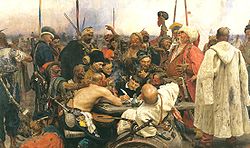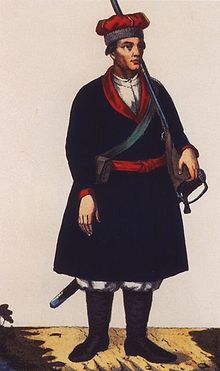- Registered Cossacks
-
Registered Cossacks (Ukrainian: Реєстрові козаки, Reyestrovi kozaky, Polish: Kozacy rejestrowi) is the term used for Cossacks formations of the Polish–Lithuanian Commonwealth armies.
Contents
Establishing
The registered cossacks were created on the King's edict of Sigismund II Augustus on June 5, 1572[1] confirming the orders of the Crown Hetman Jerzy Jazłowiecki.[2] The first senior (later hetman) was Jan Badowski.[1] The registered cossacks were the only military cossack formation recognized by the Polish-Lithuanian Commonwealth.[1]
Appointed Seniors Year Hetman Notes 1572 Jan Badowski[2] 1575 Bohdan Ruzhynsky 1578 Michał Wiśniowiecki[2] 1583 1590 1600 Havrylo Krutnevych[2] 1603 Ivan Kuchkovych[2] 1618 Petro Konashevych[2] 1622 Olifer Holub[2] elected by cossacks 1623 Mykhailo Doroshenko[2] the last senior, replaced by commissar Registered Cossacks were a military formations of Commonwealth army from 1572[1] until the year 1699 when were abolished. The most notorious of the first recorded cossack reforms came from the Polish king Stefan Batory[3] on September 16, 1578[2] when register was increased to 500 names. The new senior was appointed the starosta of Cherkasy and Kaniv Prince Michał Wiśniowiecki, while his deputy was Jan Oryszowski.[2] Batory tried to control cossack forces who waged their own wars in Moldavia and Wallachia as well as other parts of the Ottoman Empire. As the headquarters of the cossacks was picked a town of Trakhtemyriv (today's a village of Kaniv Raion) with its monastery where was located the cossack's hospital.[2] Cossacks were getting paid on the Saint Nicolas Day (see Saint Nicolas) in Cherkasy by a scribe who, at time, was Jancz Bereg.[2] That Batory's military reform, however, was not effective. The Polish government promised to pay the cossacks salary, but often did not follow that promise. Cossacks often proudly pledged their allegiance to serve the King of Poland and hoped for the same financial compensation at least as the regular army. Due to some hold ups in pay-ups cossacks continued their military engagements with Tatars and Moldavians.[2]
- Number of registered cossacks
Year Number 1572 300[1] 1578 600[1] 1583 600[4] 1590 1,000[5] In 1590 the Sejm issued a new declaration of recreating the cossack units.[2] On July 25, 1590 there was issued another King's edict on which were registered 1,000 cossacks for policing purposes to prevent uncontrolled attacks from cossacks onto neighboring countries.[2] Cossacks were paid from 5 to 12 zloty each quarter, while for the headquarters was picked the Zaporizhian Sich.[2] In 1590s, however, as the Polish interests were aimed in securing the Swedish crown, the cossack movement came somewhat out of control, particularly, the one led by Kosynsky and, later, Nalyvaiko who also was assisted by the Kosh Otaman Hryhoriy Loboda.[6]
Organization
History of Ukraine 
This article is part of a series- Cassette Scandal
- Orange Revolution
- Russia–Ukraine gas disputes
Part of a series on Cossacks 
Cossack hosts Azov · Black Sea · Buh · Caucasus · Danube · Don · Volga · Ural · Terek · Kuban · Orenburg · Astrakhan · Siberian · Baikal · Amur · Semirechye · Ussuri · Zaporozhia Other groups Danube (Sich) · Tatar Cossacks · Nekrasov · Turkey · Jewish Cossacks History Registered Cossacks · Kosiński Uprising · Nalyvaiko Uprising · Khmelnytsky Uprising · Hadiach Treaty · Hetmanate · Colonisation of Siberia · Bulavin Rebellion · Pugachev's Rebellion · 1st Cavalry Army · Decossackization · Betrayal · XV SS Cossack Cavalry Corps · 1st Cossack Division Famous Cossacks Bohdan Khmelnytsky · Petro Sahaidachny · Ivan Vyhovsky · Petro Doroshenko · Ivan Mazepa · Ivan Sirko · Yemelyan Pugachev · Stenka Razin · Yermak Timofeyevich Cossack terms Ataman · Hetman · Kontusz · Papakhi · Plastun · Szabla · Shashka · Stanitsa · Yesaul Registered Cossacks formed an elite among Cossacks, serving in the military under commanders (starshyna) and main otaman, who were responsible before Grand Crown Hetman (Commonwealth highest military commander). A substantial percent of Cossacks formed skilled light cavalry units (choragiew), excellent skirmishers trained in mounted archery (and later using firearms), making lightning raids, harassing heavier, slower formations and disengaging. Those units were often used as support for heavy elite Commonwealth cavalry, the husaria, and were much cheaper to form than a hussar unit. Cossack units were also known for their tabor formation.
Registered Cossacks had many privileges, including personal freedom, exclusion from many taxes and duties, and the right to receive wages (although the Commonwealth military was plagued with fiscal problems, leading to extremely delayed wages, often paid in items like clothes or weapons instead of coin).
Many Cossacks were skilled warriors, and Cossacks' major income source came from raids on the southern neighbors of the Commonwealth (Ottoman Empire and its vassals). However only a small number were actually 'registered Cossacks' — the exact number was from few hundred to few thousands and varied in time, usually being increased during wartime. This has led to many social and political tensions, especially as szlachta (Polish and Ukrainian gentry) continually attempted to force Cossacks into submissions as peasants, while Cossacks demanded the significant expansion of the Cossack register. Furthermore, the Cossack-szlachta conflict was aggravated as Cossacks often supported Commonwealth monarchs (like Wladyslaw IV Waza), who were often at odds with Polish szlachta, wishing to further limit the monarch's powers. The tensions between Cossacks and Polish szlachta grew and from the late 16th century resulted in several uprisings (the greatest of which was the Khmelnytsky uprising of 1648), with registered Cossacks often forced to choose sides between supporting their own people or the szlachta-backed Commonwealth forces.
Cossack Hetmanate
According to the Treaty of Zboriv, signed on August 17, 1649, the number of Registered Cossacks increased up to 40 thousand.
Table. The Seats and the Number of Registered Cossacks in 1649.[7]
-
# Seat of a Cossack regiment Number of Registered Cossacks 1 Bila Tserkva 2990 2 Bratslav 2662 3 Cherkasy 2990 4 Chernihiv 998 5 Chyhyryn 3220 6 Kalnyk 2050 7 Kaniv 3167 8 Kiev 2002 9 Korsun 3470 10 Kropyvna 1993 11 Myrhorod 3009 12 Nizhyn 991 13 Pereyaslav 2986 14 Poltava 2970 15 Pryluky 1996 16 Uman 2977
Reference
- ^ a b c d e f (Ukrainian) Registered Cassacks at the Handbook of the History of Ukraine
- ^ a b c d e f g h i j k l m n o p (Ukrainian) Реєстрові козаки на державній службі (with reference to Sherbak,V. History of Ukrainian Cossacks: outlines in two volumes. Publishing house "Kiev-Mohyla Academy". Vol.1. Kiev, 2006. p.800)
- ^ Hrushevsky, p.191
- ^ Hrushevsky, p.210
- ^ Hrushevsky, p.211
- ^ Hrushevsky, p.214
- ^ Marek Gędek. Atlas historyczny wojen polskich, pp. 90-91. Bellona, Warszawa 2009. ISBN 978-83-11-11642-9
Bibliography
Hrushevsky, M. Illustrated History of Ukraine. "BAO". Donetsk, 2003. ISBN 9665485717
Categories:
Wikimedia Foundation. 2010.


